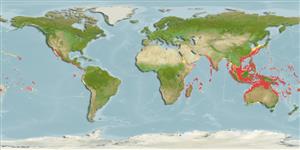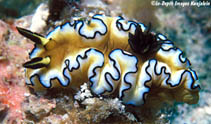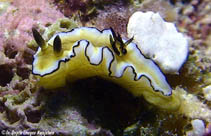Doriprismatica atromarginata (Cuvier, 1804)
Black-margined nudibranch| Native range | All suitable habitat | Point map | Year 2050 |

|
| This map was computer-generated and has not yet been reviewed. |
| Doriprismatica atromarginata AquaMaps Data sources: GBIF OBIS |
Classification / Names Common names | Synonyms | CoL | ITIS | WoRMS
| Nudibranchia | Chromodorididae
Environment: milieu / climate zone / depth range / distribution range Ecologie
; diepteverspreiding 3 - 200 m (Ref. 99750). Tropical
Verspreiding Landen | FAO regio's | Ecosystems | Voorkomen | Introducties
Indo-Pacific.
Length at first maturity / Size / Gewicht / Leeftijd
Maturity: Lm ? range ? - ? cm Max length : 9.0 cm TL mannelijk/geslacht niet bekend; (Ref. 844)
Korte beschrijving Morfologie
Ranges from creamy white to a pale brown. Characterized by the black line bordering the very sinuous mantle edge, the black edge to the rhinophore pockets, black rhinophore clubs, and the black edging to the simple gills. The gills often rhythmically wave as the animal crawls along.
Assumed maximum length from Ref. 844. Depth range based on occurrence records: minimum depth (Ref. 99751) and maximum depth (Ref. 99750); to be replaced with a better reference. Found under a dead coral head at a depth of 15 m (Ref. 866).
Life cycle and mating behavior Geslachtsrijpheid | Voortplanting | Kuitschieten | Eieren | Fecundity | Larven
Members of the order Nudibranchia are simultaneous hermaphrodites. Mating behavior: Both individuals darts their penis toward each other to induce one to act as a male and the other as the female. The victorious one to penetrate the body wall is the dominant male. Life cycle: Eggs are deposited on a substratum where they develop and hatch into (planktonic) vestigial veliger larval stage and further grow as adults.
Voornaamste referentie
Referenties | Coördinator | Medewerkers
Debelius, H. 2001. (Ref. 844)
Status op de Rode Lijst van het IUCN (Ref. 130435)
Status bij CITES (Ref. 108899)
Not Evaluated
CMS (Ref. 116361)
Not Evaluated
Gevaarlijk voor mensen
Harmless
Gebruik door de mens
| FishSource |
Tools
Meer informatie
Populaire namen
Synoniemen
Predators
Voortplanting
Geslachtsrijpheid
Kuitschieten
Fecundity
Eieren
Ontwikkeling van de eieren
Synoniemen
Predators
Voortplanting
Geslachtsrijpheid
Kuitschieten
Fecundity
Eieren
Ontwikkeling van de eieren
Internet-bronnen
BHL | BOLD Systems | CISTI | DiscoverLife | FAO(Publication : search) | Fishipedia | GenBank (genoom, nucleotide) | GloBI | Gomexsi | Google Books | Google Scholar | Google | PubMed | Tree of Life | Wikipedia (ga naar, zoek) | Zoological Record
Estimates based on models
Preferred temperature
(Ref. 115969): 20.9 - 28.3, mean 26.8 (based on 1077 cells).
Prijsklasse
(Ref. 80766):
Unknown.




